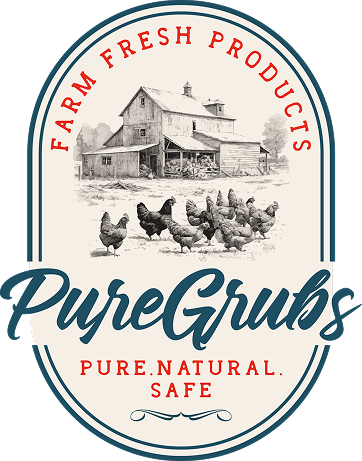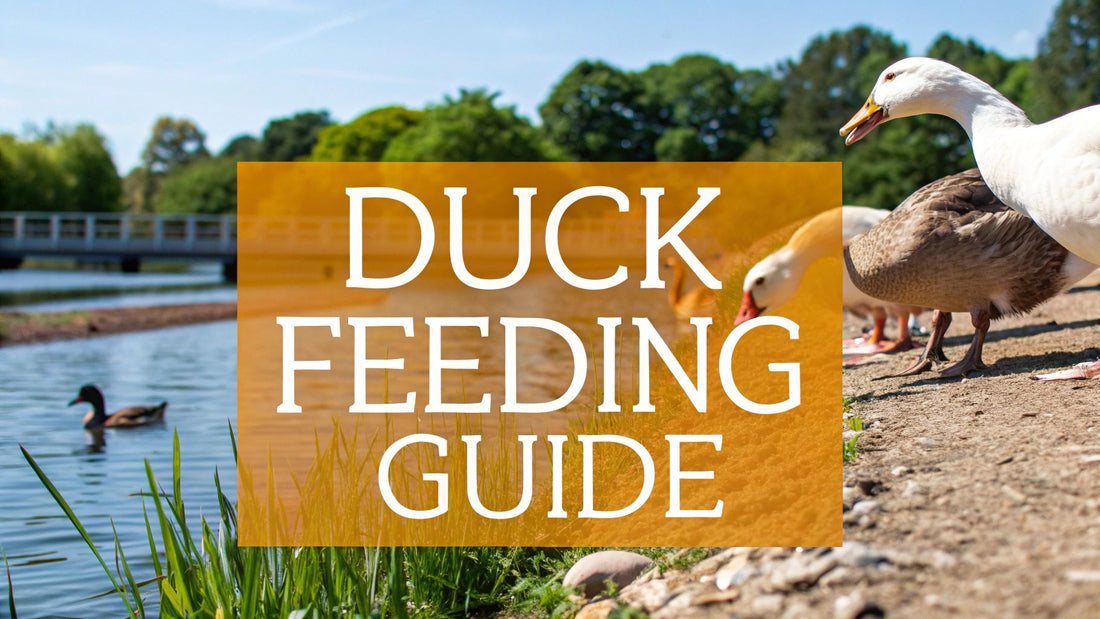
Ultimate Duck Feeding Guide: Tips for Healthy, Happy Ducks
Share
If there’s one golden rule to raising healthy ducks, it’s this: stop feeding them bread. While it might seem like a harmless treat, it’s the equivalent of junk food for your flock. The absolute best thing you can do for them is provide a high-quality commercial duck feed that's formulated for their specific age. This is what gives them the essential protein, vitamins, and minerals—especially niacin—they need to thrive.
Why Getting Duck Nutrition Right is So Important
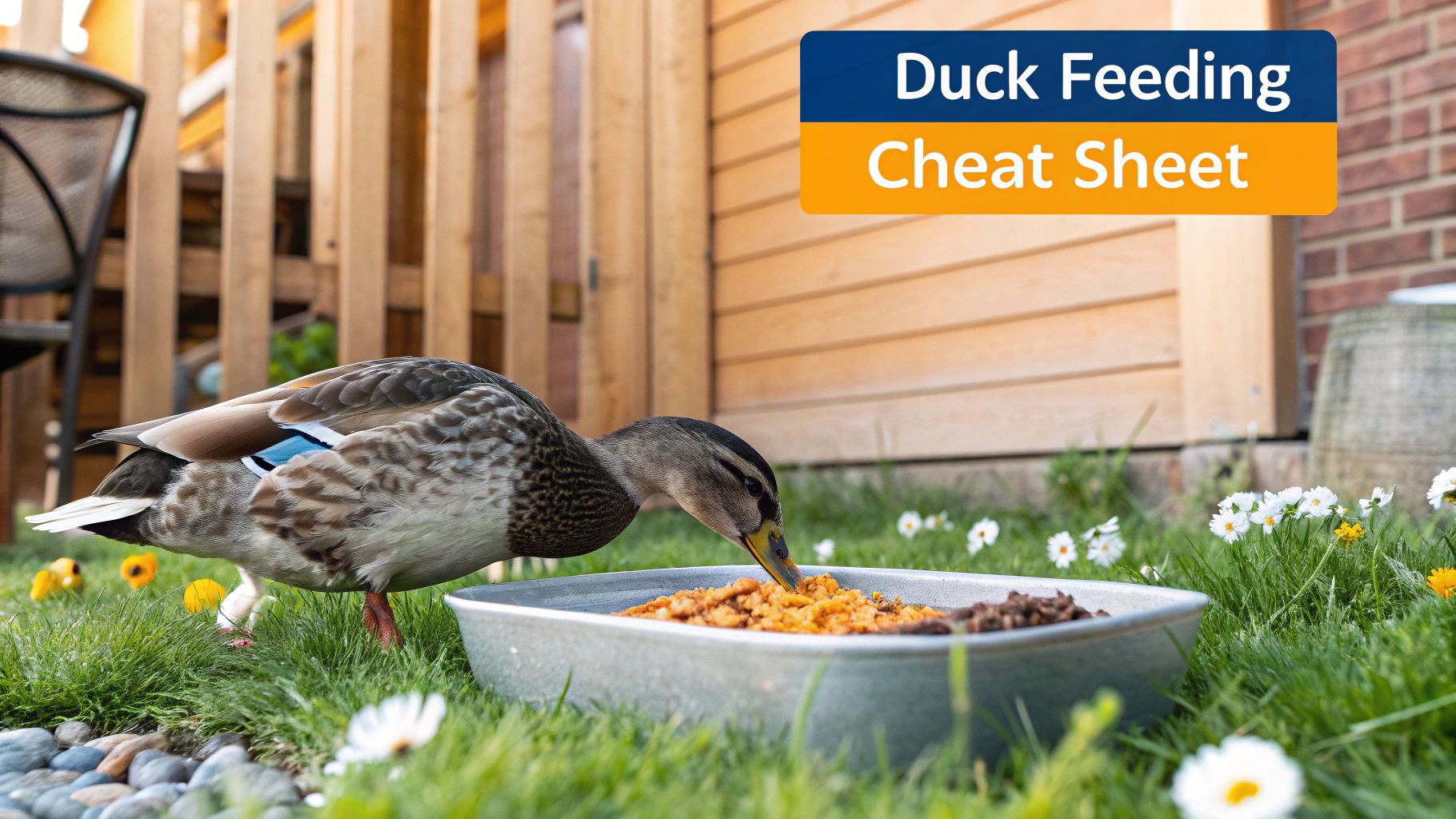
Understanding what to feed your ducks is ground zero for their overall well-being. It's easy to think they can eat the same things as chickens, but ducks have some very different dietary needs that random backyard treats just can't satisfy. For example, they need a whole lot more niacin (Vitamin B3) than chickens do to ensure their legs and joints develop properly.
A balanced diet is the foundation for everything. Think of a good commercial feed as a carefully designed meal plan that covers all the bases. It provides the exact nutrients needed for explosive growth in ducklings, brilliant feather production during their yearly molt, and strong, solid eggshells for your laying hens. Without this solid nutritional footing, ducks can run into some serious and preventable health problems.
The Cornerstones of a Healthy Duck Diet
Any good duck feeding guide boils down to a few core nutritional building blocks. Getting these right from the start helps you sidestep common health issues that can pop up later on.
- Protein: This is the fuel for muscle development and healthy feather growth. Little ducklings are growing incredibly fast, so they need a high-protein starter feed with about 20-22% protein.
- Niacin (Vitamin B3): This isn't just a "nice to have"—it's an absolute must for ducks. Niacin is critical for preventing leg deformities and supporting their neurological system. A deficiency can quickly lead to an inability to walk.
- Calcium: For the laying ladies in your flock, calcium is king. It's the primary ingredient in eggshells, and if they don't get enough, you'll start seeing thin, weak, or even soft-shelled eggs.
A huge mistake many well-meaning people make is offering ducks high-carb, low-nutrient snacks like bread, crackers, or popcorn. These junk foods can cause a heartbreaking condition called "angel wing," a wing deformity caused by a diet that's out of whack. In adult birds, it's often irreversible.
To make things a bit easier, here’s a quick reference table that breaks down what your ducks need at each stage of their lives. Think of this as your roadmap for building a great feeding routine.
Essential Duck Nutrition at a Glance
This table provides a quick summary of the primary feed types and nutritional needs for ducks at different life stages, from brand-new ducklings to mature laying adults.
| Life Stage | Primary Feed Type | Key Nutritional Focus |
|---|---|---|
| Duckling (0-3 Weeks) | Starter Crumbles | High Protein (20-22%), Niacin |
| Juvenile (4-20 Weeks) | Grower Feed | Moderate Protein (16-18%), Balanced Nutrients |
| Adult Layer (20+ Weeks) | Layer Pellets/Crumbles | Calcium, Maintained Protein (15-17%) |
Using this framework as your guide ensures you're meeting their core needs as they grow from fuzzy little ducklings into healthy, productive adults.
Understanding Your Duck's Natural Diet
To really nail down the perfect feeding plan for your ducks, you first have to think like one. Out in the wild, ducks are expert foragers. They see ponds, fields, and streams as their own personal, all-you-can-eat buffet. They aren't just sitting around waiting for someone to toss them a handful of pellets; they're actively hunting for a wide variety of foods that give them exactly what their bodies need.
This foraging instinct is the key to understanding why some foods are great for them and why others, like bread, are so incredibly harmful.
A wild duck’s day is spent dabbling and diving for all sorts of things. Their diet is a rich, varied mix of insects, aquatic plants, seeds, grains, and even small fish or crustaceans. This isn't just random snacking. It’s a very specific search for the essential building blocks they need to thrive. Every snail, every seed, and every blade of grass offers something vital for their health.
Nature has already perfected this diet. It provides the high protein they need for strong muscles and healthy feathers, and it's packed with the calcium required for solid bones. It’s a complete system, which is precisely why a good commercial duck feed is formulated to copy this natural nutritional profile as closely as possible.
The Building Blocks of a Wild Diet
Think of a duck's natural diet like a perfectly constructed meal. Each ingredient serves a critical purpose, and if you take one away, the whole thing can get thrown out of whack. A high-quality commercial feed is simply our best effort at recreating that meal in a safe, convenient, and reliable form.
Here’s a breakdown of what their wild foraging really gives them:
- Protein from Insects and Larvae: This is non-negotiable for energy, growth, and feather production. Ducks instinctively seek out high-protein snacks to fuel their busy lives.
- Calcium from Snails and Crustaceans: Those tiny shells and exoskeletons deliver the calcium they need for strong bones and, for the ladies, strong eggshells.
- Vitamins from Greens and Plants: Aquatic plants and grasses are their source of essential vitamins, including the incredibly important Niacin (Vitamin B3), which is crucial for healthy legs and joints.
- Energy from Seeds and Grains: Wild grains and seeds provide the carbs needed to keep their energy levels up for all that foraging and flying.
Mimicking Nature with the Right Supplements
While a good commercial feed should always be the main course, supplementing with treats that mimic what they’d find in nature is a fantastic way to provide enrichment and an extra nutritional kick. High-protein treats are especially beneficial. For example, insects like Black Soldier Fly Larvae (BSFL) are a powerhouse of both protein and easily absorbed calcium. If you're looking for a great source, you can find more information on where to buy Black Soldier Fly Larvae for your flock.
Just like a person can’t live on potato chips alone, a duck can't thrive on bread. Bread fills them up without offering any real nutrition, which leads to deficiencies and serious health problems like Angel Wing, a permanent wing deformity.
Once you understand this natural foundation, it becomes crystal clear why a balanced diet is so important. Any good duck feeding guide comes back to this one central idea: feed them in a way that respects their natural biology. By giving them a balanced commercial feed and supplementing with healthy, nature-inspired treats, you’re providing everything they’d find for themselves in the wild, just in a much safer package. This is the recipe for ducks that grow strong, lay healthy eggs, and live long, happy lives.
How To Choose The Right Commercial Duck Feed
Ever walk into a feed store and feel completely lost? You're hit with a wall of bags labeled "starter," "grower," and "layer," and suddenly, feeding your ducks feels like a high-stakes exam.
Don't worry, we've all been there. Choosing the right feed isn't just about grabbing any old bag; it’s about giving your flock the precise fuel they need to thrive at every single stage of life. Get it right, and you'll have healthy, happy ducks. Get it wrong, and you could run into problems down the line.
Decoding Feed Types For Every Life Stage
A tiny, downy duckling has completely different nutritional needs than a full-grown hen laying eggs every day. That’s why commercial feeds aren’t a one-size-fits-all product. They’re carefully formulated for specific growth phases.
Let’s break down the main types you'll encounter:
- Starter Feed: Think of this as the high-energy fuel for brand-new ducklings, from their first day up to about three weeks old. It’s packed with the highest protein content, typically around 20-22%, to support that incredible, rapid growth. It also contains extra Niacin (Vitamin B3), which is absolutely essential for strong leg and bone development in waterfowl.
- Grower Feed: After those first few weeks, it's time to switch to a grower formula. The protein here drops a bit to around 16-18%. This feed is all about promoting steady, healthy development without pushing growth too fast, which can help prevent leg issues.
- Layer Feed: Once your ducks are nearing laying age (usually around 20 weeks), they're ready for layer feed. The protein stays consistent at about 15-17%, but the real hero here is a significant boost in calcium. This is crucial for forming strong, solid eggshells.
This handy infographic gives a great visual of how the protein levels change as your ducks mature.
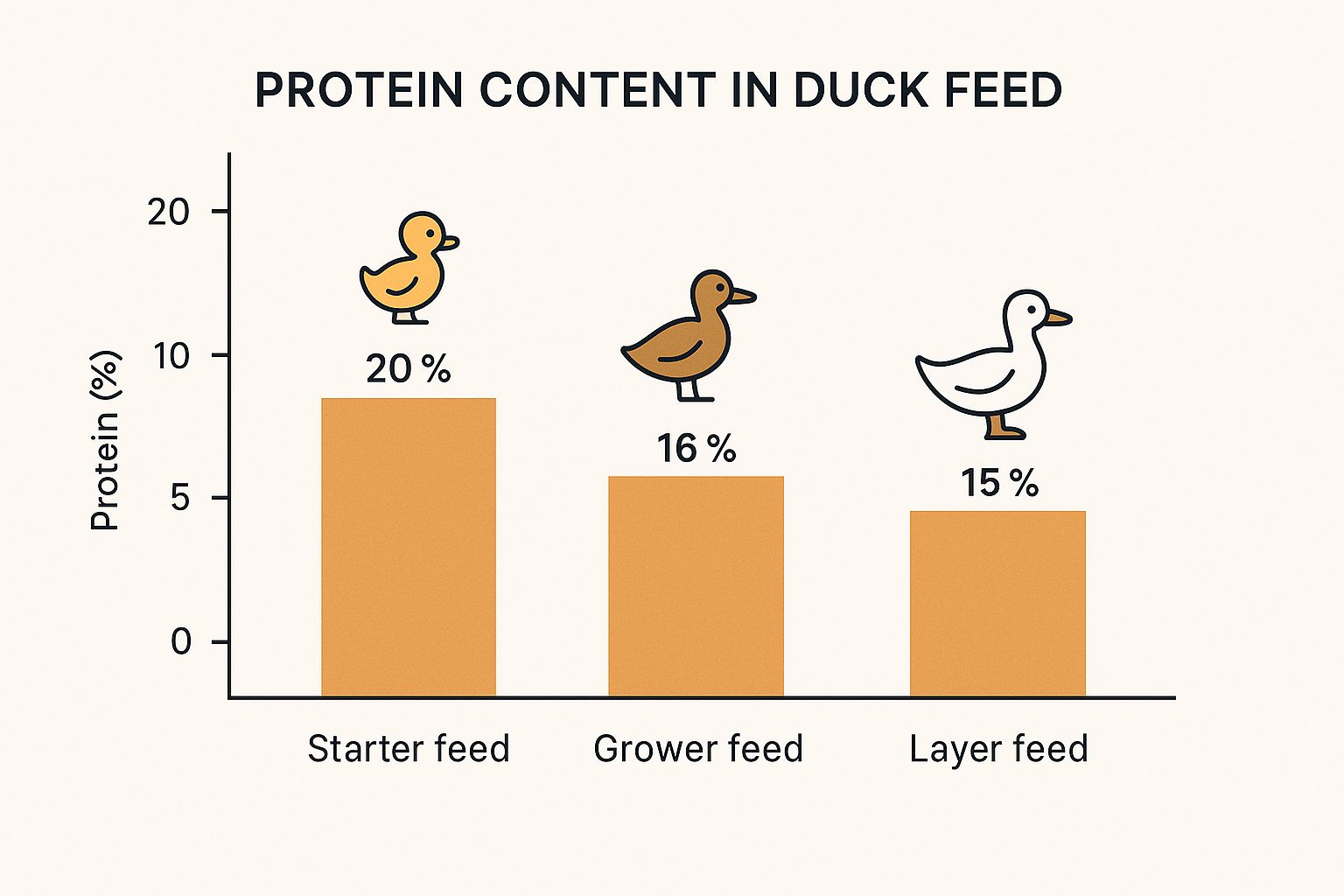
As you can see, the feed is most protein-dense for the youngest birds and then tapers off.
Comparing Commercial Duck Feed Types
To make it even clearer, let's look at these feeds side-by-side. Each one plays a unique role in your duck's journey from a tiny hatchling to a productive adult.
| Feed Type | Ideal For (Age) | Typical Protein % | Key Nutrient Focus | Common Form |
|---|---|---|---|---|
| Starter | 0-3 Weeks | 20-22% | High Protein & Niacin | Crumbles |
| Grower | 3-20 Weeks | 16-18% | Balanced Growth | Pellets/Crumbles |
| Layer | 20+ Weeks | 15-17% | High Calcium | Pellets |
Understanding this progression is the key to raising a healthy flock from start to finish.
Pellets vs. Crumbles: What’s The Difference?
Beyond the nutritional breakdown, you'll also see feed sold as "pellets" or "crumbles." The choice here is mostly about what your ducks can physically handle.
Crumbles are just pellets that have been broken up into smaller, easier-to-eat bits. This makes them perfect for tiny ducklings who would struggle to swallow a full-sized pellet.
Pellets are the larger, compressed, uniform pieces. They're great for adult ducks because they lead to less waste—ducks are less likely to scratch through and spill pellets compared to finer crumbles. While the basics are similar for poultry, you can check out our guide on the best food for chickens for a little more context on feed forms.
Key Takeaway: Never, ever give medicated chick starter to ducklings. Ducks are incredibly hearty and don't need the coccidiostat medication often found in chick feed. More importantly, they eat far more than chicks, which means they can easily ingest a toxic amount.
The focus on proper nutrition isn't just a backyard concern; it's a global trend. The duck feed market is expected to grow from $2.0 billion in 2023 to a staggering $3.5 billion by 2032. This surge reflects a worldwide understanding that a quality diet is fundamental to flock health and productivity. By getting these basics right, you’re setting your flock up for a long, healthy, and productive life.
Safe and Healthy Treats Your Ducks Will Love
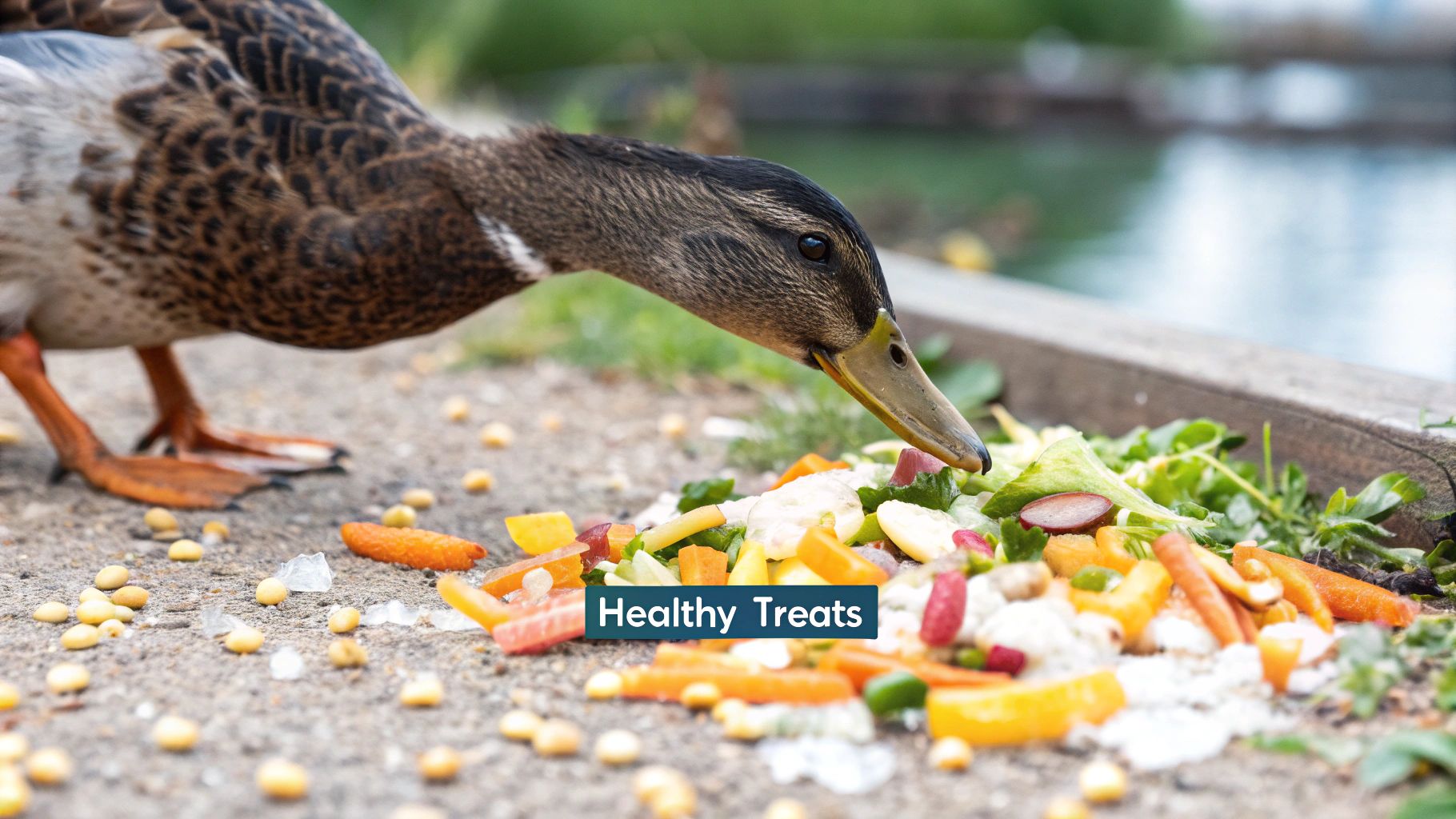
While a top-notch commercial feed should be the cornerstone of your flock's diet, treats are where the real fun begins. Offering snacks is a fantastic way to enrich their day, build a bond, and round out their nutrition.
Think of it like this: their feed is the balanced, nutritious meal, and treats are the healthy, delicious dessert. The secret is choosing snacks that mimic what ducks would naturally hunt for themselves—foods that are packed with nutrients, not just empty calories.
This is where we move beyond the daily essentials and explore the world of healthy snacks that will have your ducks waddling over in excitement. Done right, treats can be a huge boost to their health and happiness. But if you get it wrong, they can quickly derail a perfectly balanced diet.
The Golden Rule of Treating Your Flock
Before we get into the "what," we need to talk about the "how much." There's one simple, non-negotiable guideline every duck owner needs to know: the 10% rule.
Treats should make up no more than 10% of your duck’s total daily food intake. The other 90% must come from their balanced commercial feed to ensure they receive all the essential vitamins and minerals they need to thrive.
It can be tempting to spoil them, but overindulging your ducks—even with healthy stuff—can lead to weight gain, nutritional imbalances, and even serious problems like angel wing. Sticking to this rule keeps treats in their proper place as a beneficial supplement, not a dietary liability.
The Best Garden-Fresh Treats for Ducks
Ducks are natural foragers at heart, so they go absolutely nuts for fresh greens and veggies. These treats aren't just tasty; they're also a great source of extra vitamins and hydration. Just be sure to chop them into small, bite-sized pieces so everyone can enjoy them safely.
Here are a few flock-favorites you can't go wrong with:
- Leafy Greens: Ducks love kale, Swiss chard, and romaine lettuce. Just steer clear of iceberg lettuce—it's mostly water and offers very little nutritional value.
- Chopped Vegetables: Cucumbers, peas, corn (raw or cooked), and shredded carrots are all fantastic choices that add variety and a nice nutrient boost.
- Fruits in Moderation: Berries, melon, and sliced apples (always remove the seeds!) make for a wonderful sweet treat. Because of their sugar content, think of fruits as an occasional indulgence, not a daily staple.
Power-Packed Protein Snacks
Out in the wild, a huge part of a duck's diet is made up of insects, grubs, and other creepy crawlies. Bringing that element into their backyard life with high-protein treats is one of the best things you can do for them. This is especially true for laying hens or during their yearly molt, when their protein needs skyrocket.
A protein boost is critical for a few key reasons:
- Feather Production: Feathers are made of nearly 90% protein. During a molt, a protein-rich snack helps them regrow a healthy, waterproof coat much faster.
- Eggshell Strength: Calcium gets all the credit, but protein is essential for creating the strong membrane that holds the egg together.
- Muscle Development: Just like for us, protein provides the fundamental building blocks for strong, healthy muscles.
One of the absolute best protein supplements you can offer is Black Soldier Fly Larvae (BSFL). They blow mealworms out of the water, nutritionally speaking. Not only are they packed with protein, but BSFL also contain up to 85% more calcium, and it's a type of calcium that's incredibly easy for a duck's body to absorb. This makes them a superior choice for supporting strong eggshells and overall flock health.
Many of the best snacks for ducks are also great for other backyard poultry. For a broader look at healthy options, you can explore our guide on delicious and safe snacks for chickens.
Treats to Strictly Avoid
Knowing what not to feed your ducks is just as important as knowing what to give them. A lot of common human foods can be harmful or even toxic. Make sure these never make it into your flock's feeding dish:
- Bread, Crackers, and Junk Food: These are the definition of empty calories and can lead to serious health problems.
- Spinach: It contains compounds that can interfere with calcium absorption—a big no-no for laying ducks.
- Avocado, Onions, and Raw Beans: These are all toxic to ducks and should be avoided at all costs.
- Citrus Fruits: The high acidity can easily cause an upset stomach and digestive issues.
By sticking to the 10% rule and choosing nutrient-rich, natural foods, you can make treat time a safe, happy, and healthy part of your daily routine. It’s a simple way to bring a little extra joy to your ducks and contribute to their overall well-being.
Common Feeding Mistakes and Foods to Avoid
Knowing what to feed your ducks is only half the battle. Just as important is knowing what not to feed them. Many well-meaning duck owners accidentally cause serious health problems by offering the wrong foods or making simple mistakes in how they feed their flock.
Think of this as your duck safety manual. Getting this part right is one of the biggest things you can do to ensure your birds live long, healthy, and happy lives.
The Most Dangerous Foods for Ducks
A surprising number of common household foods are toxic to ducks. Their digestive systems are very different from ours, and things we eat without a second thought can make them incredibly sick. It's crucial to make sure your flock can't get into these items, whether as treats or by rummaging through the compost pile.
Here’s a list of foods that should be strictly off-limits:
- Bread & Processed Snacks: We've said it before, but it bears repeating: bread, crackers, and chips are junk food for ducks. They have almost no nutritional value and can lead to malnutrition and "angel wing," a permanent and heartbreaking wing deformity caused by a diet too high in carbs and too low in protein.
- Avocado: Every single part of the avocado—the pit, the skin, the flesh—contains a toxin called persin. It's extremely poisonous to birds.
- Onions, Garlic & Leeks: These all belong to the allium family and contain sulfur compounds that can destroy a duck's red blood cells, leading to a dangerous form of anemia.
- Raw Beans: Never feed your ducks uncooked or even undercooked beans. They contain a natural insecticide that is highly toxic to birds.
- Spinach: This one surprises people. While spinach is packed with nutrients, it also contains oxalic acid. This compound blocks calcium absorption, which is a huge problem for laying ducks who need all the calcium they can get for strong eggshells.
A common trap is thinking that because a food is "natural," it must be safe. Things like avocado and raw beans are perfectly natural, but they can be lethal to a duck. When in doubt, always research a new food before offering it.
Other Common Duck Feeding Mistakes
Beyond obviously toxic foods, a few common practices can trip up even experienced owners. These slip-ups usually happen when we forget about the unique way a duck's body works.
1. Not Enough Clean Water
Ducks are waterfowl—the clue is in the name! Water is absolutely essential for them to eat safely. They need to dunk their heads to wash down food and keep their nostrils and sinuses clear. Giving them feed without immediate access to a deep, clean water source is a major choking hazard.
2. Using the Wrong Feeder
It might seem easy to just toss food into a shallow dish, but this creates a massive, messy problem. Ducks will immediately splash water in it, spill the feed everywhere, and walk all over it. This not only wastes a ton of food but also creates a perfect breeding ground for nasty bacteria and attracts pests like rodents. Investing in a proper waterfowl feeder designed to reduce waste will save you headaches and money in the long run.
3. Breaking the 10% Treat Rule
It's so tempting to spoil your flock, but too many treats—even the healthy kind—can throw their whole diet out of whack. A good rule of thumb is the 10% rule: treats should make up no more than 10% of their daily food intake. This ensures that 90% of their nutrition still comes from their balanced, formulated feed, which prevents obesity and keeps them from missing out on vital nutrients.
The growing interest in raising ducks, both for meat and eggs, really shines a light on how important proper care is. The global duck meat market hit about $3.20 billion in 2024 and is expected to climb to $5.89 billion by 2034. This trend shows that more people are recognizing the value of these birds, and that starts with understanding their nutritional needs right in your own backyard. You can read more about these valuable insights into the global duck market.
A Simple and Effective Feeding Schedule That Works
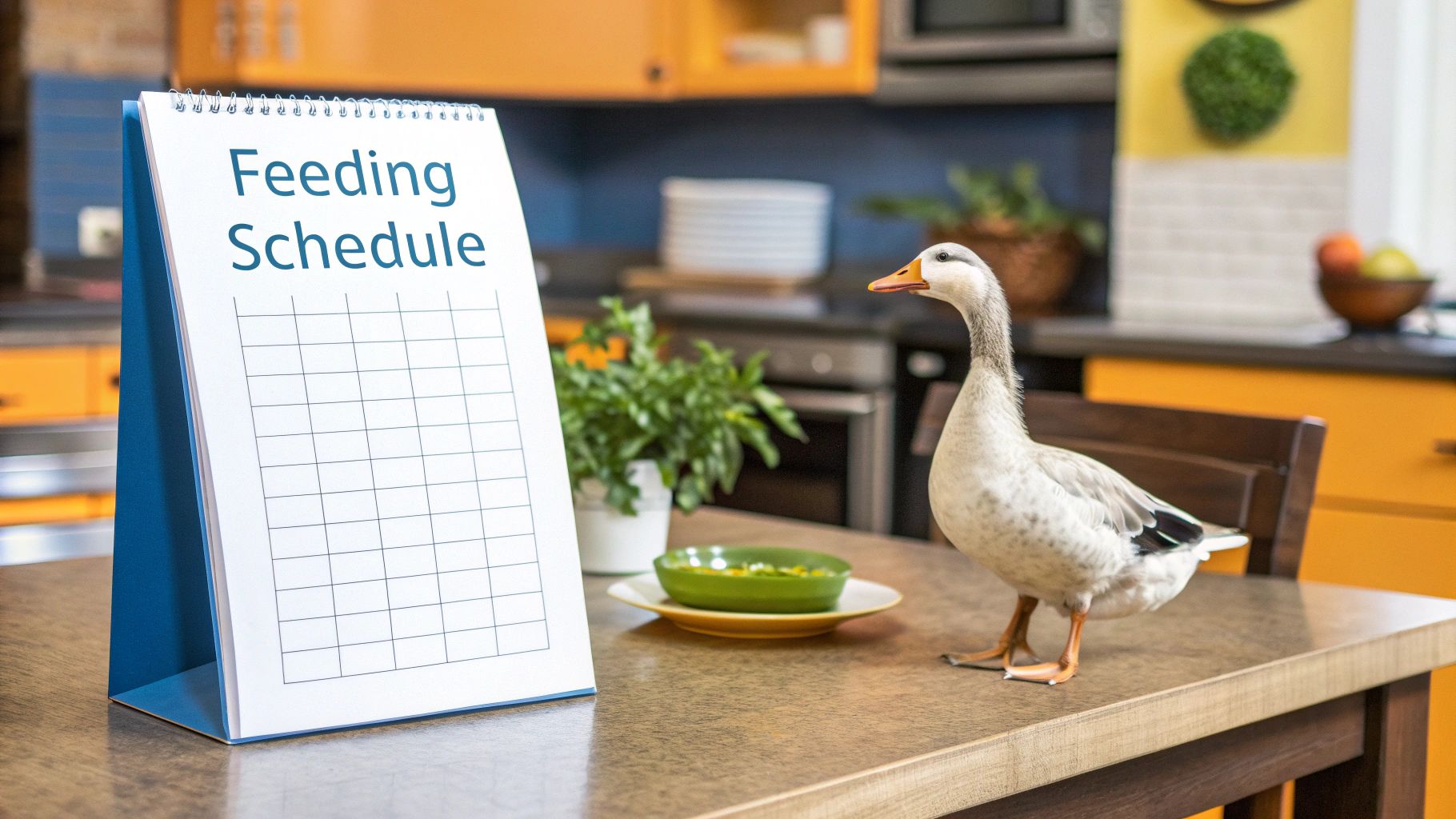
Knowing what to feed your ducks is half the battle. The other half is figuring out when and how. A good, consistent schedule is the secret sauce to a healthy flock. It keeps your birds happy, cuts down on wasted feed, and helps you sidestep the problems that come with overfeeding.
The aim here is to create a rhythm your ducks can count on. It's less about a rigid, to-the-minute timetable and more about establishing a dependable daily pattern. This ensures they get everything they need without turning their pen into an all-you-can-eat buffet that attracts every pest in the neighborhood.
Free Feeding Versus Set Mealtimes
One of the first decisions to make is whether to leave food out all day or serve it at specific times. Both approaches have their pros and cons, and what's best really hinges on the age of your ducks and your specific setup.
- Free-Feeding (Ad Libitum): This is just what it sounds like—food is available at all times. It's the go-to method for ducklings, who are growing at a breakneck pace and need constant fuel. For adult ducks, however, free-feeding can easily lead to obesity and an open invitation for mice and rats.
- Set Mealtimes: For most adult ducks, feeding a measured amount twice a day—once in the morning and again in the evening—is the way to go. This puts you in the driver's seat, giving you total control over portions, drastically reducing waste, and making your coop far less attractive to rodents. A full-grown duck generally eats about four to seven ounces of feed per day.
Key Takeaway: No matter how you schedule their meals, clean water is an absolute must. Ducks need to dunk their heads and slurp water to swallow their food properly. Eating without it is a serious choking hazard for them.
Feeding Ducklings Versus Adults
You'll need to adjust your feeding strategy as your ducks grow up. Their needs change dramatically from fluffy little ducklings to full-grown adults.
Ducklings (0-8 weeks):
Ducklings are essentially eating-and-growing machines. They need round-the-clock access to their high-protein starter crumbles, so keep that feeder full. Just be sure to dump any leftovers at the end of the day. Damp, old feed can get moldy and become dangerous for them to eat.
Adult Ducks (8+ weeks):
Once that initial growth spurt is over, it's time to switch to set mealtimes. This is key to keeping them at a healthy weight and getting them into a predictable routine. Always use a proper poultry feeder to keep the feed clean and off the ground—it saves money and helps maintain a much cleaner coop.
This focus on better nutrition isn't just a backyard trend. The global duck feed market is expected to grow significantly, potentially hitting $800 million by 2033. This growth is fueled by a broader understanding of how crucial proper feeding is for raising healthy, productive birds. You can learn more about the growing duck feed industry and its trends.
Answering Your Top Duck Feeding Questions
Even with the best plan, questions are bound to pop up. Whether you're just starting with your first ducklings or you've been raising a flock for years, we all hit a snag now and then. Here are some of the most common questions we get, with practical answers to help you out.
Think of this as your quick-reference guide for those moments when you need a clear answer, fast. Getting these details right helps you feel more confident and keeps your ducks happy and healthy for the long haul.
Can I Give My Ducks Chicken Feed?
You can, but only in a real pinch—it should never be their regular diet. The biggest problem is that chicken feed is seriously lacking in Niacin (Vitamin B3), a vitamin ducks need in much higher amounts than chickens. Without enough niacin, ducks can develop severe leg and joint problems, which is especially risky for growing ducklings.
If you have no other option for a day or two, you absolutely must supplement it. The easiest way is to mix in some brewer's yeast to boost the niacin. But honestly, the best move is always to get a feed made specifically for waterfowl. Their health is worth it.
How Can I Tell If My Ducks Are Overweight?
Obesity in domestic ducks is surprisingly common. A key sign is a heavy, low-slung belly that might even drag on the ground. You might also notice they seem clumsy or have trouble walking. If you consistently find a lot of leftover food after they've eaten, that's another red flag.
The best way to keep them at a healthy weight is to stop free-feeding adults and switch to measured meals twice a day. And most importantly, live by the 10% rule for treats. This rule ensures that treats are just that—a treat—and that their main nutrition comes from their balanced feed.
A duck that stops eating is a major cause for concern. Before you panic, check their feed to make sure it hasn't gone stale, damp, or moldy. Watch the flock dynamics—is the duck being bullied away from the food? Also, make sure their water is deep enough for them to clear their bills, as they need water to swallow properly. If a duck doesn't eat for more than a day or seems lethargic, it's time to call a vet.
Are Dried Grubs A Meal Or A Treat?
Dried grubs like Black Soldier Fly Larvae (BSFL) are an amazing treat, but they are not a complete meal. They're packed with protein and easy-to-absorb calcium, but they don't have the full range of vitamins and minerals your ducks need to thrive.
It’s better to think of them as a powerful supplement. Grubs are perfect for giving your ducks an extra boost during a molt when they need protein for feather regrowth, or for helping hens lay eggs with strong, solid shells. Use them to complement their main feed, not replace it.
Looking for a high-protein, high-calcium treat that will support brilliant feathers and strong eggshells? Consider adding Pure Grubs to your flock's diet. Our USA-grown Black Soldier Fly Larvae are a safe, natural, and nutritious supplement your ducks will absolutely go wild for. Learn more and shop now at PureGrubs.com.
